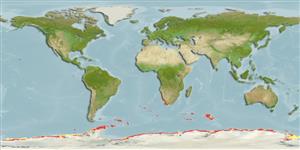Common names from other countries
Classification / Names / Names
Noms communs | Synonymes | Catalog of Fishes (gen., sp.) | ITIS | CoL | WoRMS
Environment: milieu / climate zone / depth range / distribution range
Écologie
; profondeur 14 - 423 m (Ref. 7424). Polar
Distribution
Pays | Zones FAO | Écosystèmes | Occurrences | Introductions
Southeast Atlantic and the Antarctic: Antarctica and South Africa.
Length at first maturity / Taille / Poids / Âge
Maturity: Lm ? range ? - ? cm
Description synthétique
Morphologie
Stolonal colonies composed of stolons creeping on substratum and giving rise to sock-shaped hydrothecae, adnate to substratum to a varied degree. Adnate part of hydrothecae provided with striae on dorsal side; striation highly variable. Hydrothecal aperture circular, rim even. Cnidome composed of two kinds of nematocysts, small and large ones. Coppinia composed of a set of firmly adpressed gonothecae surrounded by a fence of long defensive tubes usually curved towards the centre of the gonothecal mass in such a way that they constitute a nest or corbula. Defensive tubes forked or unforked, provided with distal, circular aperture. Gonotheca tubular, basally truncated and with a distal, unraised, circular aperture, usually on a slightly raised, cone-shaped part. Eggs remaining on gonothecae, immersed in a sort of nourishing mass.
Found at depths of 13.5 to 400 m (Ref. 7424).
Life cycle and mating behavior
Maturité | Reproduction | Frai | Œufs | Fécondité | Larves
Found with coppinia in January to February and June. Material was collected in December to February.
Peña Cantero, A.L., A. Svoboda and W. Vervoort. 2004. (Ref. 7424)
Statut dans la liste rouge de l'IUCN (Ref. 130435)
statut CITES (Ref. 108899)
Not Evaluated
Not Evaluated
Utilisations par l'homme
| FishSource |
Outils
Plus d'informations
Taille/ÂgeCroissanceLongueur-poidsLongueur-longueurMorphologieLarvesAbondance
Sources Internet
Estimates based on models
Preferred temperature
(Ref.
115969): 0.2 - 10.5, mean 1.8 (based on 51 cells).
Catégorie de prix
Unknown.
